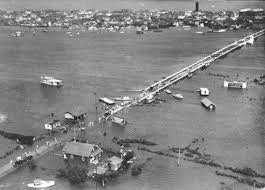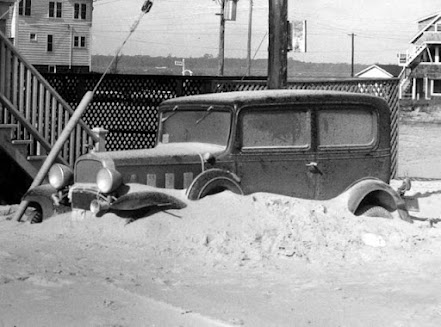Ocean City and the 1933 Chesapeake-Potomac Hurricane
The long strip of barrier island was known as Assateague to the Jincoteague Indian tribe for generations. It had been used for hunting and fishing purposes for as far back as the tribal sagas told stories of the past. Then Englishman Thomas Fenwick bought the long strip of land from the Native Americans, and gave it his own surname - Fenwick Island. (But the Virginians still called the long barrier peninsula Assateague; and since the northern part of this peninsula was marsh, and had to be crossed by boat, they also tagged on Island to the end of the name.) Fenwick ran his stock on Fenwick - horses, cattle, sheep, swine, etc., and the livestock was generally rounded up annually for culling, selling, and slaughter. He also rented the land to other livestock owners to augment his income. A few hardy families moved onto Fenwick near 1800.
Fishing was a way of life on Fenwick/Assateague, but the only way to get the boats out to sea and then back in to land was through the Atlantic surf. Teams of men, horses, mules and oxen were used to tow the fishing boats in and out of the surf. For a few years, this was made much easier by storms making inlets between the ocean and Sinepuxent Bay; then the fishermen had easy access. An inlet was formed in the early 1800s near what is now 110th Street, and closed a few years later. Near the turn of the 20th century, another inlet opened (and closed a few years later) about 5 miles south of Ocean City's location.
Isaac Coffin, a Maryland-born farmer who resided and farmed in Berlin, built the first cottage on the beach at Ocean City for paying guests. In 1860, he and his wife Amanda had 7 children (all girls except Isaac, Jr) and he owned real estate worth $3,000 and had a personal estate of $600. In 1870, a year after he built his first rental cottage, his real estate was worth $2,000 and his personal worth was $1,000 (this was after the Civil War, too, remember). With the success of his one cottage, he soon built several more, and he and his wife were able to provide good dowries for their daughters and live comfortably after retirement. Prior to 1870, what is now Ocean City was called "The Ladies' Resort to the Ocean."
With Coffin's success, several boarding houses sprang up on the strand and became great money-makers for other men. This brought the attention of prominent businessmen from Baltimore, Philadelphia and Wilmington. They purchased a large area of the island and a corporation was formed for land development. The corporation stock consisted of 4,000 shares and sold for $25 for each share. It was agreed to develop the property into 250 lots for building.
The first major hotel in Ocean City to open was the Atlantic Hotel, which opened on 4 July 1875. It was originally owned by the Atlantic Hotel Company; Charles Purnell purchased it in 1923, and the Purnell family still owns the hotel.
Prior to 1878, one arrived at Ocean City via train, then stagecoach, then boat. In 1878 the Wicomico & Pocomoke Railroad took visitors from Berlin to the shore of Sinepuxent Bay and then a ferry delivered them to the ocean-front town. By 1881, the railway was complete and passengers disembarked at the train station on Philadelphia Avenue, while returning trains carried freshly caught fish back to major eastern cities.
The railroad bridge to Ocean City was washed out by the 1933 hurricane.
Beginning about 1907 groups of businessmen, including hoteliers and fishermen, had been asking their legislators within the state, and the representatives in Congress to approve the construction of an inlet five miles below the southern end of Ocean City. They pointed out it would help draw tourism for fishing if they had an easy in-and-out inlet to reach the Atlantic. A short film was produced showing the hard labor that took place to get the fishing boats through the surf to go out and return from any fishing experience. Much more money could be made, and much less exertion and time would be used if only the US Department of Engineers and the US Coast Guard would approve the cutting and dredging of an inlet. Much thought and debate was given each year to these pleas, but they were never approved. (See https://www.youtube.com/watch?v=EiokjrDnzEc )
Aerial view of the new Ocean City Inlet showing the waters from
SinepuxentBay poring into the Atlantic Ocean, above; residents in
front of the newly-formed inlet once the rain stopped, below.
The Ocean City Beach Patrol was formed in 1930 to protect the bathers who now stretched as far as the eye could see along the boardwalk. The men combined policing and lifeguard skills, and this was formed in collaboration between Mayor William C. McCabe and Coast Guard Captain William Purnell.
The US Weather Bureau was informed of the Chesapeake-Potomac Hurricane* when it formed on 13 August 1933 near Africa; it began tracking it on 18 August, and issued the first storm warnings early on the morning of 21 August. But the eastern shores of the United States had been receiving bands of rain from the storm since 18 August. Newspapers state that Ocean City had suffered through 4 consecutive days with 10 inches of rain falling before the storm actually struck the beach community on 22 August. (See https://vimeo.com/70042665 )
The rain, winds and tides of the hurricane seemed to last forever. Finally the rain and wind stopped on the 24th. The people who had stuck it out through the hurricane - without electricity, water, sewer, telephone or telegraph - stepped out to see what was left of their hometown. They found their world had changed.
Parts of the boardwalk were washed away, as were homes and businesses all along the waterfront. Partially collapsed buildings were a frequent sight. Huge piles of beach sand were left in the streets. The old railroad bridge that had been the only way to enter or leave the town - other than by boat - was also gone, and it was never rebuilt. Instead, the state built a bridge over Isle of Wight Bay and sent US 50 right into Ocean City, opening the resort for car traffic.
With the immense amounts of rain caught within the confines of Sinepuxent Bay and Chincoteague Bay to the south, and with the Chincoteague causeway acting as a stopper in a bottle, allowing very little water to escape from the Bays, something had to give. At that point in time, there were several streets containing homes and businesses further south than South 1st Street. Apparently there was some weakness or fault or just enough "give" to the sand just south of South 1st Street - because, between the wind, waves, and overflowing Bay, the ground at that point gave way - and a new, fast-flowing inlet into the Atlantic appeared, swallowing homes and businesses alike. Ocean City now ends at South 2nd Street. When residents and visitors walked down to 1st Street to view the new inlet, they were amazed that they could watch the waters widening the breach in the sand as mere minutes passed by.
The inlet breach south of 1st Street was a God-send in another way. Besides giving access to Sinepuxent Bay to the fishermen (and soon after, the fishing and hunting guides), it also allowed the Bay to be flushed out - literally. The town of Ocean City had been pumping sewage into the bay since the turn of the century; now the turning tides could clean out the accumulated affluent and clean the water for fish and other wildlife to resume living on the Bay. With the new turning tides, bringing fresher, more salty ocean water, the oyster and clam business took off, and Sinepuxent Bay began to vie with Chincoteague for oyster vendors.
The Ocean City business community had wanted a man-made inlet dug and dredged through their tiny peninsula; Mother Nature stepped in and lent a hand. The government slipped over to the city's side and soon a large dredging operation happened, along with two long stone jetties. The jetties served to send the shifting ocean sands toward the (now) southern end of Ocean City, and the beaches grew wider and enjoyed a great many visitors. Word soon slipped out to fishermen that Ocean City was becoming a White Marlin Capital; commercial and tourist-driven fishing thrived.
Assateague Island, too, has been affected by the jetties and dredging of the Ocean City Inlet. The northern end of Assateague has shifted almost two-thirds of a mile to the west since the jetties were placed in 1934/5. The northern end of Assateague has also been shrinking, because the jetties block the sand needed to replenish the northern marshes and dunes on the island.
Map showing how Assateague has changed near the Ocean City jetties
The 2020 Census shows Ocean City has a year-round population of 6,844, with the average age just a hair shy of 54 1/2 years of age. The city now spreads from the Delaware state line in the north, almost 10 miles south to the Ocean City Inlet, made by the 1933 Hurricane.
* The hurricane that struck the mid-Atlantic states during August 1933 is being called the "Chesapeake-Potomac Hurricane" these days. Hurricanes were not given names until the 1950s, and this hurricane was - and usually is - referred to as the Great Hurricane of 1933 or the August 1933 Hurricane.. There were 20 tropical storms and hurricanes in 1933; it was the sixth storm and third hurricane of that season. Since it caused the greatest damage in the Chesapeake Bay and Potomac River areas, recent scientists gave it the name "Chesapeake-Potomac Hurricane."













Comments
Post a Comment